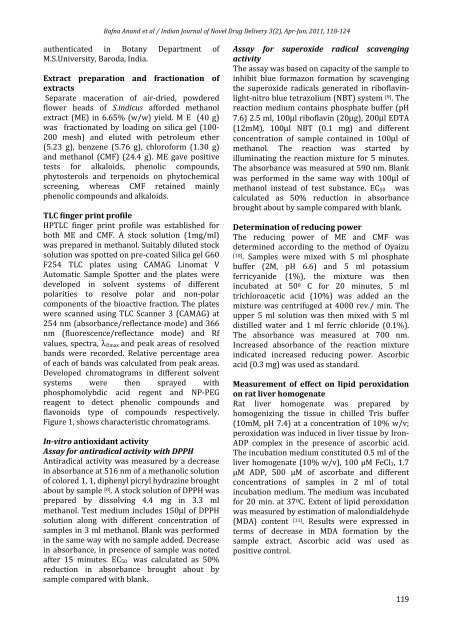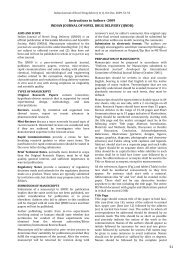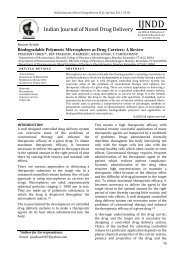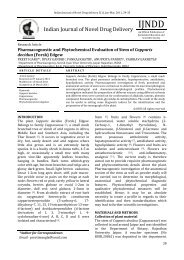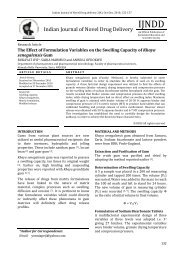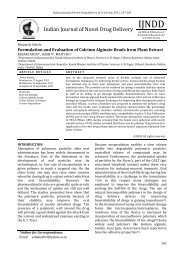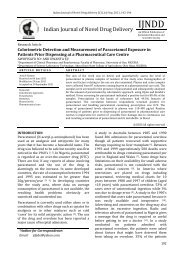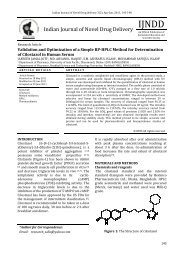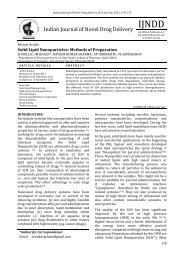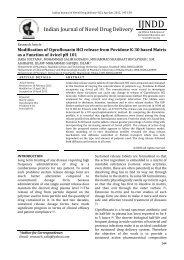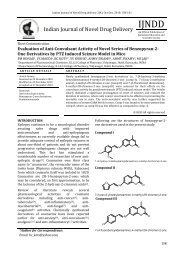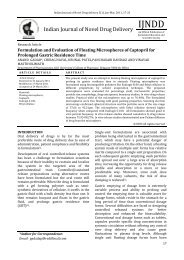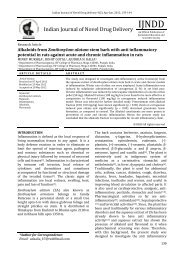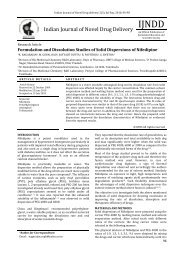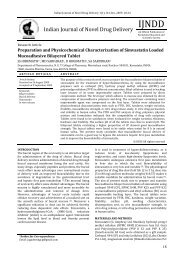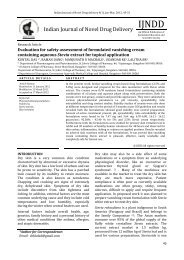Evaluation of Antioxidant Properties of Flower Heads of ...
Evaluation of Antioxidant Properties of Flower Heads of ...
Evaluation of Antioxidant Properties of Flower Heads of ...
You also want an ePaper? Increase the reach of your titles
YUMPU automatically turns print PDFs into web optimized ePapers that Google loves.
Bafna Anand et al / Indian Journal <strong>of</strong> Novel Drug Delivery 3(2), Apr-Jun, 2011, 118-124<br />
authenticated in Botany Department <strong>of</strong><br />
M.S.University, Baroda, India.<br />
Extract preparation and fractionation <strong>of</strong><br />
extracts<br />
Separate maceration <strong>of</strong> air-dried, powdered<br />
flower heads <strong>of</strong> S.indicus afforded methanol<br />
extract (ME) in 6.65% (w/w) yield. M E (40 g)<br />
was fractionated by loading on silica gel (100-<br />
200 mesh) and eluted with petroleum ether<br />
(5.23 g), benzene (5.76 g), chlor<strong>of</strong>orm (1.30 g)<br />
and methanol (CMF) (24.4 g). ME gave positive<br />
tests for alkaloids, phenolic compounds,<br />
phytosterols and terpenoids on phytochemical<br />
screening, whereas CMF retained mainly<br />
phenolic compounds and alkaloids.<br />
TLC finger print pr<strong>of</strong>ile<br />
HPTLC finger print pr<strong>of</strong>ile was established for<br />
both ME and CMF. A stock solution (1mg/ml)<br />
was prepared in methanol. Suitably diluted stock<br />
solution was spotted on pre-coated Silica gel G60<br />
F254 TLC plates using CAMAG Linomat V<br />
Automatic Sample Spotter and the plates were<br />
developed in solvent systems <strong>of</strong> different<br />
polarities to resolve polar and non-polar<br />
components <strong>of</strong> the bioactive fraction. The plates<br />
were scanned using TLC Scanner 3 (CAMAG) at<br />
254 nm (absorbance/reflectance mode) and 366<br />
nm (fluorescence/reflectance mode) and Rf<br />
values, spectra, λ max and peak areas <strong>of</strong> resolved<br />
bands were recorded. Relative percentage area<br />
<strong>of</strong> each <strong>of</strong> bands was calculated from peak areas.<br />
Developed chromatograms in different solvent<br />
systems were then sprayed with<br />
phosphomolybdic acid regent and NP-PEG<br />
reagent to detect phenolic compounds and<br />
flavonoids type <strong>of</strong> compounds respectively.<br />
Figure 1, shows characteristic chromatograms.<br />
In-vitro antioxidant activity<br />
Assay for antiradical activity with DPPH<br />
Antiradical activity was measured by a decrease<br />
in absorbance at 516 nm <strong>of</strong> a methanolic solution<br />
<strong>of</strong> colored 1, 1, diphenyl picryl hydrazine brought<br />
about by sample [8] . A stock solution <strong>of</strong> DPPH was<br />
prepared by dissolving 4.4 mg in 3.3 ml<br />
methanol. Test medium includes 150µl <strong>of</strong> DPPH<br />
solution along with different concentration <strong>of</strong><br />
samples in 3 ml methanol. Blank was performed<br />
in the same way with no sample added. Decrease<br />
in absorbance, in presence <strong>of</strong> sample was noted<br />
after 15 minutes. EC 50 was calculated as 50%<br />
reduction in absorbance brought about by<br />
sample compared with blank.<br />
Assay for superoxide radical scavenging<br />
activity<br />
The assay was based on capacity <strong>of</strong> the sample to<br />
inhibit blue formazon formation by scavenging<br />
the superoxide radicals generated in rib<strong>of</strong>lavinlight-nitro<br />
blue tetrazolium (NBT) system [9] . The<br />
reaction medium contains phosphate buffer (pH<br />
7.6) 2.5 ml, 100µl rib<strong>of</strong>lavin (20µg), 200µl EDTA<br />
(12mM), 100µl NBT (0.1 mg) and different<br />
concentration <strong>of</strong> sample contained in 100µl <strong>of</strong><br />
methanol. The reaction was started by<br />
illuminating the reaction mixture for 5 minutes.<br />
The absorbance was measured at 590 nm. Blank<br />
was performed in the same way with 100µl <strong>of</strong><br />
methanol instead <strong>of</strong> test substance. EC 50 was<br />
calculated as 50% reduction in absorbance<br />
brought about by sample compared with blank.<br />
Determination <strong>of</strong> reducing power<br />
The reducing power <strong>of</strong> ME and CMF was<br />
determined according to the method <strong>of</strong> Oyaizu<br />
[10]. Samples were mixed with 5 ml phosphate<br />
buffer (2M, pH 6.6) and 5 ml potassium<br />
ferricyanide (1%), the mixture was then<br />
incubated at 50 0 C for 20 minutes, 5 ml<br />
trichloroacetic acid (10%) was added an the<br />
mixture was centrifuged at 4000 rev./ min. The<br />
upper 5 ml solution was then mixed with 5 ml<br />
distilled water and 1 ml ferric chloride (0.1%).<br />
The absorbance was measured at 700 nm.<br />
Increased absorbance <strong>of</strong> the reaction mixture<br />
indicated increased reducing power. Ascorbic<br />
acid (0.3 mg) was used as standard.<br />
Measurement <strong>of</strong> effect on lipid peroxidation<br />
on rat liver homogenate<br />
Rat liver homogenate was prepared by<br />
homogenizing the tissue in chilled Tris buffer<br />
(10mM, pH 7.4) at a concentration <strong>of</strong> 10% w/v;<br />
peroxidation was induced in liver tissue by Iron-<br />
ADP complex in the presence <strong>of</strong> ascorbic acid.<br />
The incubation medium constituted 0.5 ml <strong>of</strong> the<br />
liver homogenate (10% w/v), 100 µM FeCl 3, 1.7<br />
µM ADP, 500 µM <strong>of</strong> ascorbate and different<br />
concentrations <strong>of</strong> samples in 2 ml <strong>of</strong> total<br />
incubation medium. The medium was incubated<br />
for 20 min. at 37 0 C. Extent <strong>of</strong> lipid peroxidation<br />
was measured by estimation <strong>of</strong> malondialdehyde<br />
(MDA) content [11] . Results were expressed in<br />
terms <strong>of</strong> decrease in MDA formation by the<br />
sample extract. Ascorbic acid was used as<br />
positive control.<br />
119


